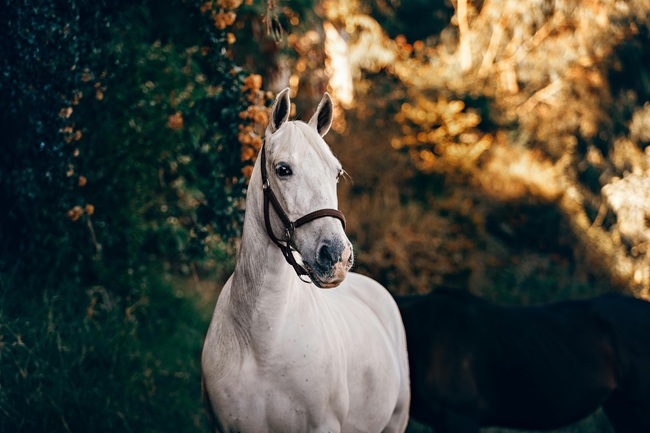One of the keys to safely working with your horse is understanding natural horse behavior. If you can predict when a horse is about to be aggressive or spook at something, you are better able to respond and either avoid a dangerous situation or prevent that behavior. Horses are good at letting us know exactly how they are feeling; the only problem is most people don’t know how to speak “horse.” So here are some tips on reading a horse’s body language.

Horse Facial Expressions
Snapping
This is seen in foals showing submission to an older horse. They will open their mouths and draw back the corners, then open and shut their jaws. Jaws open with teeth exposed: this shows aggression or possible attack.
The Flehmen Response
This is caused by an intense or unusual smell, usually in stallions when they sense a mare in heat. They stick their nose in the air and curl the upper lip over their nose.
Flared Nostrils
This usually means they are excited or alert.
Showing White Around the Eyes
This normally means they are angry or scared, although white around the eyes is also a normal characteristic of the Appaloosa breed.
Horse Ears
Neutral
When the ears are held loosely upward, openings facing forward or outward.
Pricked
Ears held stiff with openings pointed directly forward means the horse is alert.
Airplane Ears
The ears flop out laterally with openings facing down, usually meaning the horse is tired or depressed.
Drooped Ears
The ears hang down loosely to the side, usually meaning tiredness or pain.
Ears Angled Backward
When ears are angled backward with the openings directed back towards a rider it usually means attentiveness to the rider or listening to commands.
Ears Pinned Back
Ears pinned flat against the neck means watch out! The horse is angry and aggressive.
Communication
Horses have a variety of methods of vocal and non-vocal communication. Vocal noises include a squeal or scream which usually denotes a threat by a stallion or mare. Nickers are low-pitched and quiet. A stallion will nicker when courting a mare; a mare and foal nicker to each other; and domestic horses nicker for food. Neighs or whinnies are the most familiar and include high-pitched, drawn-out sounds that can carry over distances. Horses whinny to let others know where they are and to try to locate a herd mate. They also respond to each other’s whinnies even when out of sight. Blowing is a strong, rapid expulsion of air resulting in a high-pitched whooshing” sound, which usually is a sign of alarm used to warn others. Snorting is a more passive, shorter lower pitched version of blowing and is usually just a result of objects entering the nasal passage. In contrast to signals of aggression within a herd, there are also signs of friendship. Mares and foals nudge and nuzzle each other during nursing or for comfort, and mutual grooming, when two horses nibble at each other, is often seen.
Social Structure
A herd of wild horses consists of one or two stallions, a group of mares, and their foals. The leader of the herd is usually an older mare (the “alpha mare”), even though one stallion owns the herd. She maintains her dominant role even though she may be physically weaker than the others. The older mare has had more experiences, more close encounters, and survived more threats than any other horse in the herd. The requirement of the lead horse is not strength or size; if this were so, then humans could never dominate a horse. Dominance is established not only through aggression but also through attitudes that let the other horses know she expects to be obeyed.
The stallion’s job is to be the herd’s guardian and protector, while maintaining reproductive viability. The stallion’s harem usually consists of 2 to 21 horses, with up to 8 of those being mares and the rest their offspring. When the colts are old enough to be on their own, they will form a bachelor herd. The fillies will either remain in their natural herd or more commonly disperse into other herds or form a new herd with a bachelor stallion. As soon as a stallion becomes too old to maintain his status as herd owner, he is replaced by a younger stallion from a bachelor herd. The average time for a stallion to remain leader is about 2 years, but some last more than 10 years.
Horses are most vulnerable when they are eating or drinking. So, when a horse is submissive, it will simulate eating by lowering its head, chewing, and licking its lips (similar to snapping mentioned above). Dominance occurs when a horse forces the other to move against its will. One horse will move its body in the direction of or in contact with the other, forcing it to move. Fighting usually occurs when the dominant horse is challenged by the other horse not moving or responding aggressively.
Provided by Creatures Corner reader Carey A. Williams, Ph.D.
Related Articles & Free Email Newsletter Sign Up
How Horses Sleep and Why it’s Important That They Do
How to Maintain a Healthy Tail on a Horse


Comment here